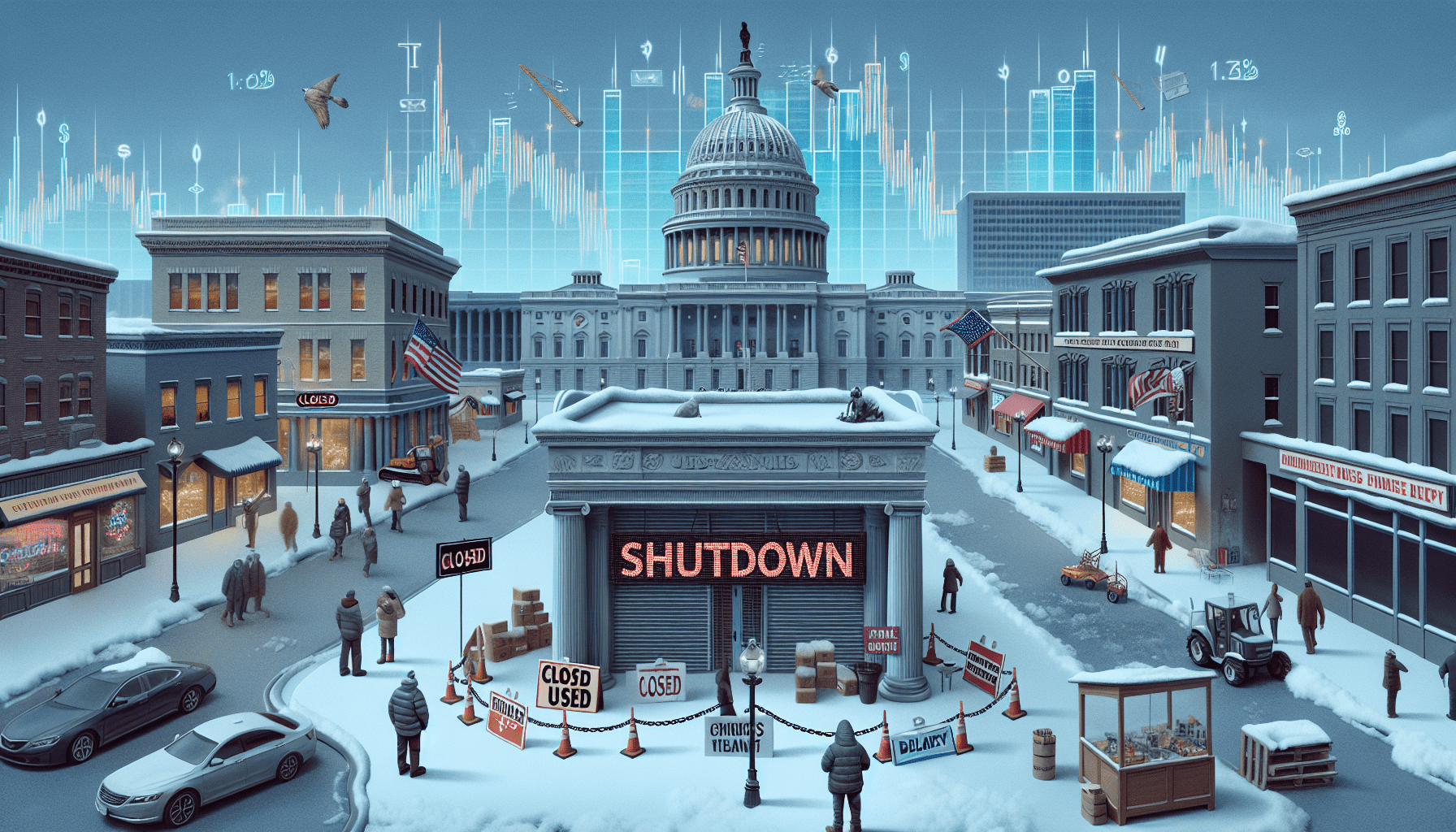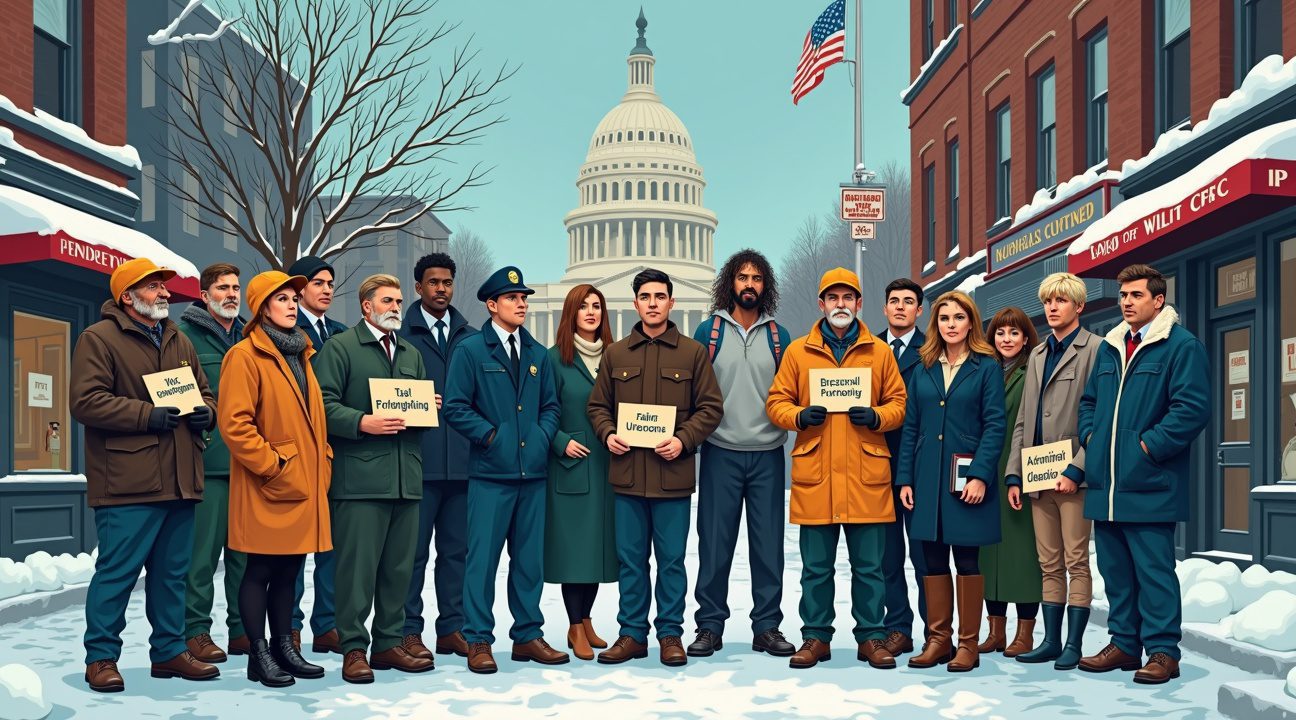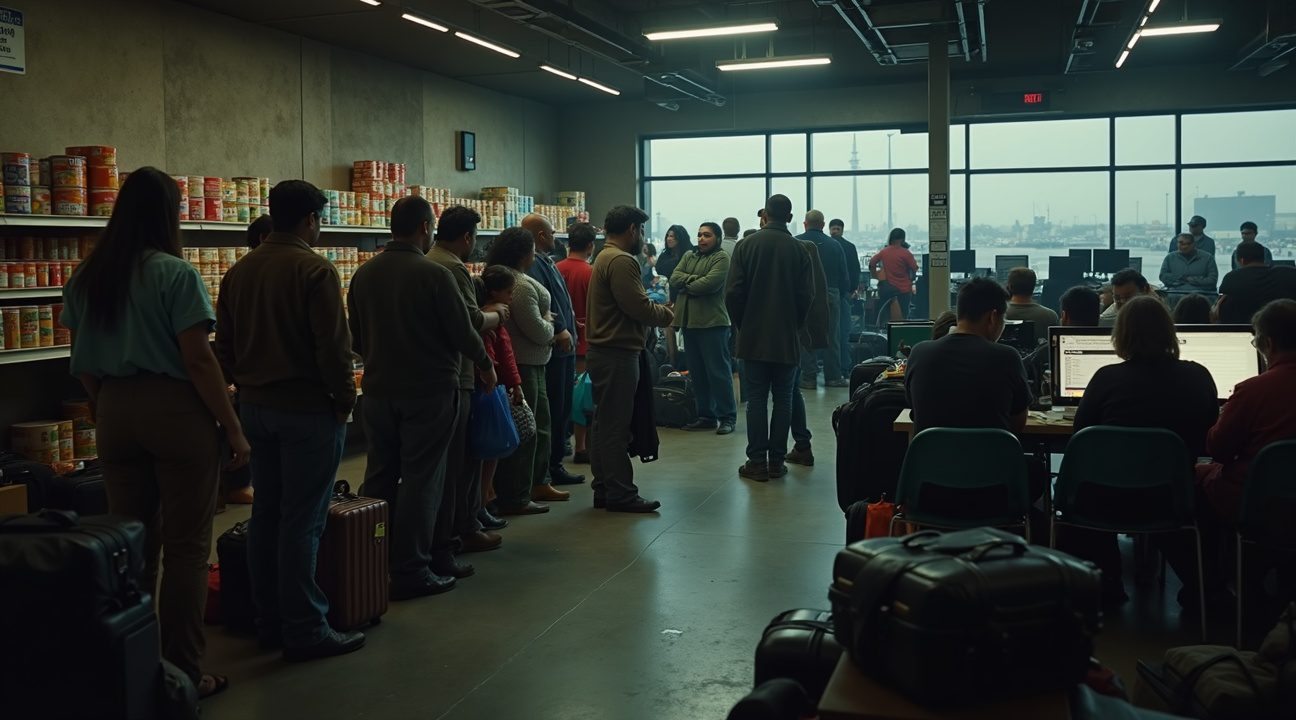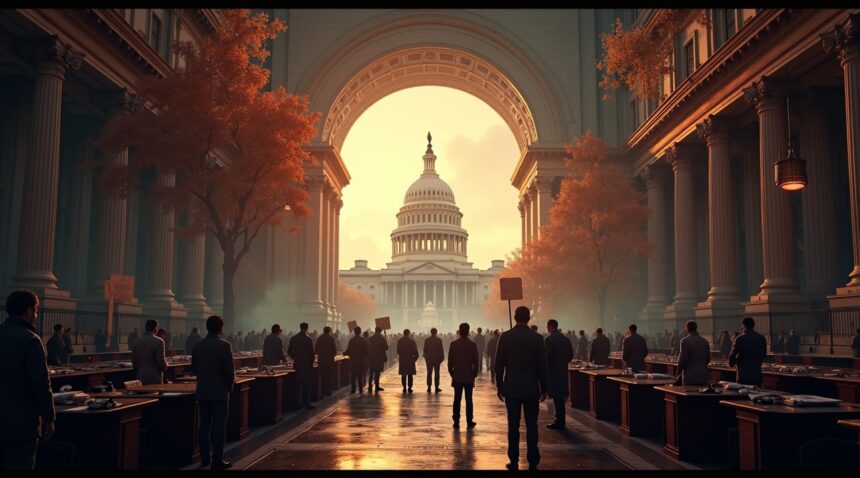The US government shutdown that lasted 36 days became the longest in American history, emerging from a congressional deadlock between House Republicans and Senate Democrats over critical funding priorities including healthcare subsidies.
This unprecedented crisis paralyzed federal operations, created severe economic disruption with $11 billion in GDP losses, and left nearly 3 million federal workers facing financial hardship while essential services operated with skeleton crews.
Key Takeaways
- The shutdown was driven by irreconcilable differences between the Republican-led House and Democratic-led Senate, with the Senate rejecting 14 House-passed continuing resolutions by November 5.
- Economic impact was severe, reaching $11 billion in GDP losses, with $3 billion becoming permanently unrecoverable. Each week of the shutdown reduced annualized GDP growth by approximately 0.1%.
- Nearly 3 million federal workers were affected, including 900,000 facing furloughs and around 2 million required to continue working without pay until the shutdown ended.
- Critical public services were threatened, including potential suspension of SNAP benefits for 40 million Americans. By November 14, 10% of flights were being canceled due to air traffic controller shortages.
- The crisis marked a historical precedent, officially becoming the longest government shutdown in US history on November 5, surpassing the previous 35-day record and entering uncharted territory for federal governance.
For more information about how government shutdowns affect the economy and public services, you can visit the official explanation on the Congressional Budget Office’s website.
Congressional Deadlock Fuels Historic Stalemate
The unprecedented government shutdown emerged from a fundamental breakdown in the legislative process, where multiple budget proposals collapsed under the weight of partisan disagreements. I witnessed how the Republican-led House and Democratic-led Senate became entrenched in their respective positions over critical funding priorities, creating an impasse that paralyzed federal operations.
House-Senate Divide Over Funding Mechanisms
Congressional dysfunction reached new heights as both chambers rejected each other’s proposals with predictable regularity. The House maintained its recess throughout much of the shutdown period, while Senate Democrats systematically opposed Republican appropriations bills due to their exclusion of Affordable Care Act subsidy extensions. House Republicans refused to budge on their funding stance, creating a cycle of rejection that defined this historic stalemate.
By November 5, the Senate had rejected 14 House-passed continuing resolutions, with votes following predictable party lines. Each rejection deepened the crisis and moved the country further from a resolution. The pattern became clear: neither side possessed the political will to compromise on their core demands, despite mounting pressure from federal workers and essential services grinding to a halt.
Economic Stakes Behind the Political Theater
The Congressional Budget Office’s analysis revealed the substantial financial implications underlying this political battle. According to CBO projections, extending enhanced health care subsidies would increase the insured population by 3.8 million Americans while adding $350 billion to the federal deficit by 2035. These numbers illustrate why Biden administration officials viewed ACA subsidies as essential to their healthcare agenda.
Republican leadership argued that such spending increases were fiscally irresponsible, while Democrats insisted that healthcare coverage represented a fundamental government responsibility. This philosophical divide over federal spending priorities transformed routine budget negotiations into an ideological battleground. The shutdown’s duration reflected how deeply entrenched these competing visions had become within each party’s base.
Congressional leaders found themselves trapped between constituent expectations and political reality. House Republicans couldn’t abandon their spending reduction promises without facing primary challenges, while Senate Democrats couldn’t accept cuts to healthcare programs without betraying their core supporters. The resulting deadlock demonstrated how polarized American politics had become, with compromise viewed as political weakness rather than governing necessity.
The continuing resolution process, typically a straightforward mechanism for temporary funding, became weaponized in this environment. Each failed vote reinforced partisan narratives while federal workers remained caught in the crossfire of this legislative dysfunction.
Economic Damage Mounts as Shutdown Drags On
The financial toll of the 2018-2019 government shutdown became increasingly severe as it stretched beyond five weeks. J.P. Morgan estimates revealed that each week of shutdown subtracted approximately 0.1% from annualized GDP growth, creating a cascading effect that rippled through the entire economy. This prolonged disruption ultimately reduced GDP by $11 billion, with economists determining that $3 billion of that loss became permanently unrecoverable.
Private Sector Faces Mounting Pressures
Businesses across the country experienced significant challenges as the shutdown extended well beyond previous historical precedents. Key areas of private-sector impact included:
- Investment decisions delayed or canceled due to regulatory uncertainty
- Consumer spending patterns disrupted as federal employees faced financial strain
- Hiring processes stalled in sectors dependent on government contracts
- Supply chain disruptions affecting companies relying on federal agencies for permits and approvals
The extended nature of this shutdown created unprecedented risks for private-sector investment confidence. Companies that typically relied on government data releases, regulatory approvals, and federal contracts found themselves operating in an information vacuum. Consumer spending took a noticeable hit as approximately 800,000 federal workers went without paychecks, reducing discretionary spending in communities with high concentrations of government employees.
Stock markets demonstrated surprising resilience during the initial weeks of the shutdown, with major indices showing limited sensitivity to the political gridlock. However, financial analysts noted growing concerns about long-term economic productivity as essential government functions remained suspended. Political uncertainty began weighing more heavily on investor sentiment as the shutdown approached its fifth week.
Safe-haven assets experienced temporary spikes during periods of heightened political tension. Gold prices saw modest increases as investors sought protection against potential economic volatility. Treasury yields fluctuated as markets attempted to price in the various scenarios for resolution and their potential impacts on fiscal policy.
The deficit increase became another significant concern as the shutdown’s costs mounted without corresponding reductions in government spending. Essential services continued operating with skeleton crews, while the economic disruption reduced tax revenues from affected workers and businesses. This dual impact created a particularly damaging scenario for long-term fiscal health, especially given that previous shutdowns had typically lasted only days rather than weeks.
Manufacturing sectors experienced notable disruptions as regulatory agencies suspended normal operations. Companies requiring FDA approvals, EPA permits, or Commerce Department certifications faced mounting delays that threatened production schedules and revenue projections. The ripple effects extended far beyond Washington D.C., affecting economic productivity in states across the nation.

Nearly Three Million Federal Workers Face Hardship
The 36-day government shutdown created unprecedented financial strain for federal workers across the country. Approximately 2.3 million federal government employees, excluding the United States Postal Service, found themselves caught in a political standoff that directly impacted their livelihoods and ability to serve the public.
Furloughs and Unpaid Work Burden
During this historic shutdown, about 900,000 federal employees faced furloughs, meaning they couldn’t work and wouldn’t receive pay until the government reopened. Another 2 million workers found themselves in an equally challenging position — they were required to report to work but wouldn’t receive compensation until Congress resolved the funding crisis.
This situation affected workers across various government departments and agencies, from customs officers at border crossings to scientists conducting critical research. Many employees struggled to pay mortgages, rent, and other essential bills while uncertainty loomed over when their next paycheck might arrive. Some turned to food banks, while others took temporary jobs to make ends meet during the extended closure.
Essential Services Continue Amid Agency Shutdowns
Critical government functions remained operational throughout the shutdown, though often with reduced staff working without pay. The Department of Defense continued its operations, ensuring national security remained intact. Transportation Security Administration agents kept airports functioning, though longer wait times became common as some workers called in sick. Medicare and Medicaid programs continued processing claims and providing healthcare coverage to millions of Americans.
However, several important agencies faced partial or complete shutdowns that disrupted public services:
- The National Institutes of Health suspended most research activities, potentially delaying critical medical breakthroughs and clinical trials.
- The Centers for Disease Control and Prevention reduced its disease surveillance and outbreak response capabilities at a time when public health monitoring remained crucial.
- The Women, Infants, and Children nutrition program faced severe disruptions. Many state WIC programs ran out of federal funding and had to rely on reserve funds or temporarily close, affecting approximately 7 million participants.
- Food safety inspections significantly decreased, as the Food and Drug Administration suspended routine inspections of food facilities.
- Federal courts began experiencing funding shortages, threatening the justice system’s ability to function normally.
- National parks closed to visitors, costing local economies millions in lost tourism revenue.
- Small businesses couldn’t access loans from the Small Business Administration, hampering economic growth in local communities.
- Weather forecasting and climate monitoring services operated with skeleton crews, potentially compromising public safety during severe weather events.
- The Internal Revenue Service delayed processing tax refunds for millions of Americans, creating additional financial stress during tax season.
The shutdown’s impact extended beyond federal workers to contractors, local businesses, and communities that depend on government operations. Restaurants near federal buildings saw significant drops in customers, while contractors providing services to shuttered agencies faced their own financial hardships without the prospect of back pay that federal employees eventually received.
As the shutdown stretched on, concerns grew about the long-term effects on government operations and worker morale. Some experienced federal employees considered leaving government service entirely, potentially creating a brain drain that could affect government efficiency for years to come. The situation highlighted the far-reaching consequences of using government funding as a political bargaining chip, demonstrating how political decisions can have immediate and lasting impacts on millions of Americans who depend on government services and employment.

Food Benefits and Flight Cancellations Disrupt Daily Life
The unprecedented 36-day government shutdown created widespread disruptions across essential services that millions of Americans depend on daily. I observed how families found themselves caught between political gridlock and their basic needs for food assistance and reliable transportation.
Critical Food Assistance Programs Face Suspension
The shutdown struck hardest at vulnerable populations relying on federal nutrition programs. On October 27, the USDA delivered devastating news when it announced that no SNAP benefits would be issued for November, threatening food security for approximately 40 million Americans. This decision created immediate hardship for families who depended on these monthly benefits to put food on their tables.
Similar challenges emerged with the WIC program, which provides nutritional support for pregnant women, new mothers, and young children. The suspension of these vital services highlighted how political decisions directly impacted the most vulnerable members of society. Court intervention eventually forced distribution in some states, but the uncertainty and delayed assistance caused significant stress for families already struggling financially.
Aviation Industry Struggles with Staff Shortages
Air travel became increasingly problematic as the shutdown progressed, with the FAA facing critical staffing shortages among air traffic controllers. By November 7, these shortages compelled airlines to reduce their flight schedules by 4% to maintain safety standards. The situation deteriorated further when flight cancellations reached 10% by November 14, creating ripple effects throughout the transportation system.
I noticed how these cancellations disrupted business travel, family visits, and vacation plans across the country. The aviation industry’s struggles demonstrated how government shutdowns extend far beyond federal employees, affecting private sector operations and everyday travelers. Airlines faced mounting pressure to accommodate stranded passengers while maintaining safety protocols with reduced air traffic control capacity.
Public opinion polls revealed growing frustration with both political parties as Americans watched essential services deteriorate. The shutdown’s impact on food assistance and air travel created tangible consequences that families couldn’t ignore. These disruptions affected not just those directly dependent on federal programs, but also anyone traveling during this period or working in industries connected to government services. The combination of food insecurity and transportation challenges painted a clear picture of how government dysfunction translates into real-world hardship for ordinary citizens.

Key Dates That Defined the Crisis
The 36-day government shutdown unfolded through a series of critical moments that revealed the escalating severity of this unprecedented crisis. Each milestone brought new challenges that affected millions of Americans and highlighted the political gridlock gripping Washington.
The First Critical Weeks
October 1 marked the beginning when government operations ceased after Congress failed to pass appropriations bills before the midnight deadline. Federal employees faced immediate furloughs while essential services continued with skeleton crews. By October 22, the situation had deteriorated significantly as the shutdown became the second-longest in American history, with continuous failed votes in Congress demonstrating the deep political divisions preventing resolution.
The crisis deepened on October 27 when the USDA announced it would pause November SNAP benefits, threatening food security for nearly 40 million Americans. However, court interventions provided some relief by ordering partial SNAP distribution, though uncertainty remained for millions of families relying on these critical benefits.
Breaking Records and Escalating Impact
November 4 brought a grim milestone as the shutdown tied the previous record of 35 days set during the 2018-2019 crisis. Just one day later, on November 5, it officially became the longest government shutdown in American history at 36 days, surpassing all previous records and entering uncharted territory for federal operations.
The consequences expanded beyond federal workers and benefit recipients during November 7–14, when the Federal Aviation Administration imposed flight cancellations that progressively increased throughout this period. Air travel disruptions affected millions of passengers as understaffed air traffic control towers struggled to maintain safe operations. These cancellations rippled through the economy, affecting businesses and travelers nationwide.
Throughout this extended period, courts played an increasingly important role in mitigating the shutdown’s most severe effects. Public pressure mounted as stories emerged about federal workers visiting food banks and struggling to pay mortgages. Legal interventions ensured continued distribution of SNAP benefits and other critical services, though often at reduced levels that still left many Americans vulnerable.
The shutdown’s timeline reveals how quickly a political standoff can spiral into a humanitarian crisis. Each passing day brought new complications, from delayed tax refunds to shuttered national parks, creating a cascade of economic and social disruptions that extended far beyond the federal workforce. Political leaders faced mounting pressure as public opinion shifted against the prolonged stalemate, ultimately forcing negotiations that would end this historic crisis.

Sources:
USAFacts, “The 2025 government shutdown is the longest in US history”
J.P. Morgan, “US Government Shutdown: What’s the Impact?”
Wikipedia, “2025 United States federal government shutdown”
Committee for a Responsible Federal Budget, “Government Shutdowns Q&A: Everything You Should Know”
CBO, “The Effects of the Partial Shutdown Ending in January 2019”
The Partnership for Public Service, “The government shutdown is now the longest ever—and the public is paying the price”
EY, “US government shutdown hits US economy”
YouTube, “US government shutdown hits 36 days, surpassing previous record”
TCW, “U.S. Government Shutdown: A Look at Past Impact and Future…”


